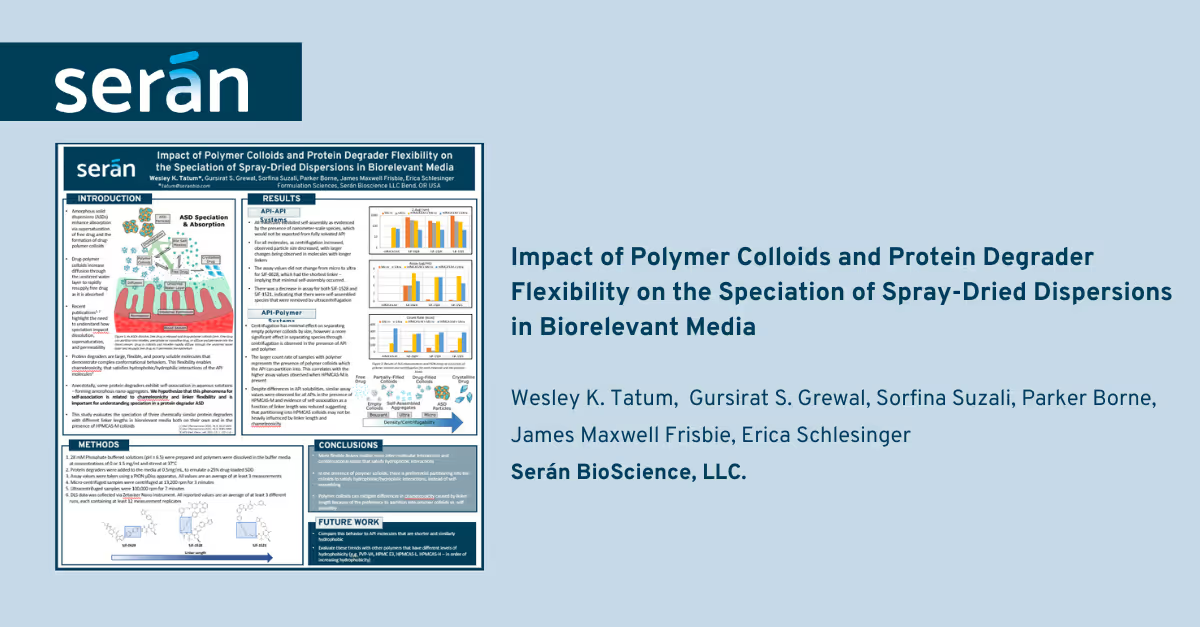Impact of Polymer Colloids and Protein Degrader Flexibility on the Speciation of Spray-Dried Dispersions in Biorelevant Media
Impact of Polymer Colloids and Protein Degrader Flexibility on the Speciation of Spray-Dried Dispersions in Biorelevant Media
Wesley K. Tatum, Gursirat S. Grewal, Sorfina Suzali, Parker Borne, James Maxwell Frisbie, Erica Schlesinger
Introduction:
• Amorphous solid dispersions (ASDs) enhance absorption via supersaturation of free drug and the formation of drug-polymer colloids
• Drug-polymer colloids increase diffusion through the unstirred water layer to rapidly resupply free drug as it is absorbed
• Recent publications1, 2 highlight the need to understand how speciation impacts dissolution, supersaturation, and permeability
• Protein degraders are large, flexible, and poorly soluble molecules that demonstrate complex conformational behaviors. This flexibility enables chameleonicity, that satisfies hydrophobic/hydrophilic interactions of the API molecules 3
• Anecdotally, some protein degraders exhibit self-association in aqueous solutions – forming amorphous nano-aggregates. We hypothesize that this phenomena for self-association is related to chameleonicity and linker flexibility and is important for understanding speciation in a protein degrader ASD
• This study evaluates the speciation of three chemically similar protein degraders with different linker lengths in biorelevant media both on their own and in the presence of HPMCAS-M colloids
Conclusions:
• Centrifugation has minimal effect on separating empty polymer colloids by size, however a more significant effect in separating species through centrifugation is observed in the presence of API and polymer
• The larger count rate of samples with polymer represents the presence of polymer colloids which the API can partition into. This correlates with the higher assay values observed when HPMCAS-M is present
• Despite differences in API solubilities, similar assay values were observed for all APIs in the presence of HPMCAS-M and evidence of self-association as a function of linker length was reduced suggesting that partitioning into HPMCAS colloids may not be heavily influenced by linker length and chameleonicity
About Serán
Serán BioScience, LLC, is a science-driven Drug Development Partner, recognized as a world leader in drug development. Utilizing a foundation of physical and chemical science, Serán designs robust formulations and engineered solutions to some of the industry's toughest drug product problems. Our experience and background cover a wide range of pharmaceutical manufacturing concepts bringing our world-class expertise to you and your drug product. Serán’s team has decades of experience developing complex drug molecules into enabling medicines. With every addition to our team, we further our commitment to our clients’ success. From preclinical to GMP and beyond, Serán is here to support you and your drug product every step of the way.
For more information, visit www.Seranbio.com or email us at hello@seranbio.com.
Contact
Serán BioScience, LLC
63047 Layton Ave, Bend, OR 97701 USA
www.seranbio.com
.svg)
%20(1).svg)


